Comparison of The Topography of Access Control Systems

Access control systems used to be very complicated and difficult to wire. The early access systems used a central control box that connected to all the doors. The wiring was complex and expensive to install.
The latest access control solutions bring all the control functions to the door. This makes it easier to install, and simpler to expand. There are several systems that connect to the network but have different wiring schemes.
We compared the different access control systems and the benefits and disadvantages of each system configuration.
This article compares four types of door control systems. They all use access control management software that runs on your Windows computer. We provided the pros and cons of the different wiring topographies.
The review includes systems that use central controller boxes, a system that uses an IP reader with a built-in controller, a biometric IP reader/controller system, and a hybrid system that uses a controller at each door.
Network Attached Central Control Box
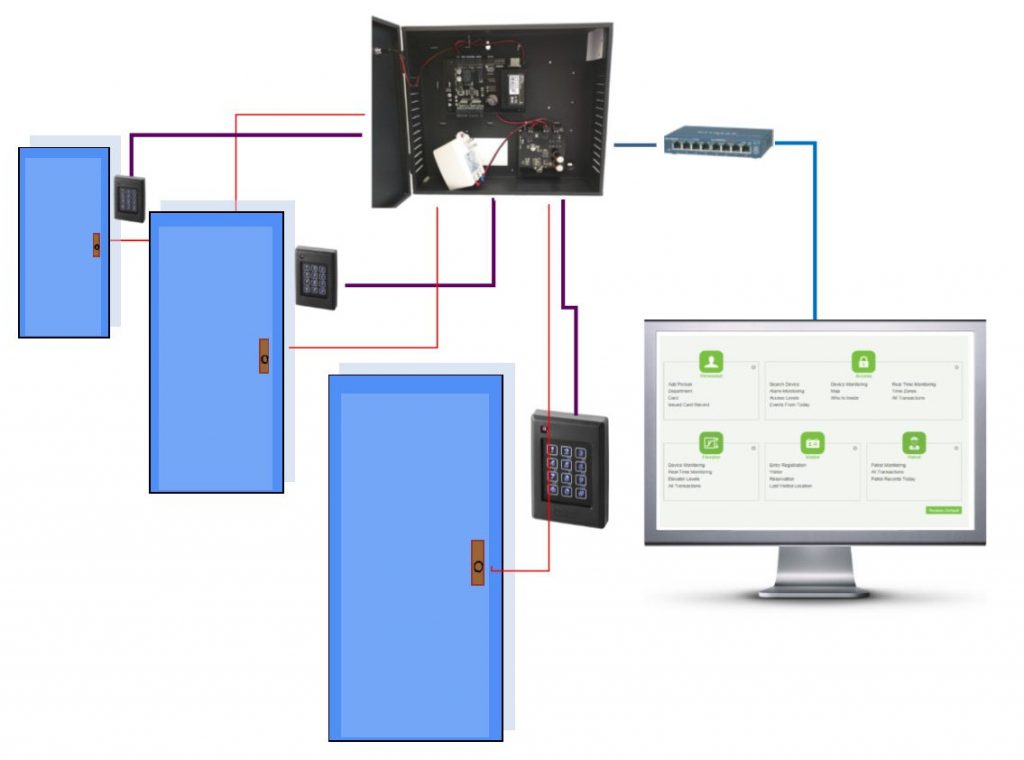
In this access control system, all the intelligence for the access control system is in a central control box. All the door readers are connected to this controller, and the controller is connected to the network.
This configuration is similar to the original central control boxes except the controller is connected to the network. The management software runs on your Windows computer, and there is an optional software app for your mobile phone.
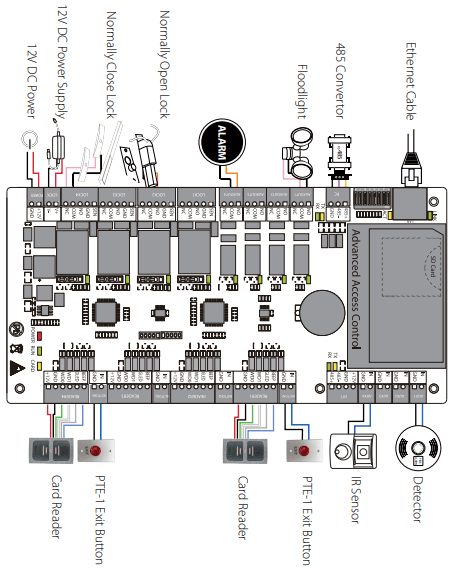
Pro: The controller box supports from one to four doors and has many IO connections for REX button, sensing the door, and relay outputs to control other devices. The network connections make it easy to connect multiple control boxes. Some controller models support biometric readers and can store fingerprint credentials.
Con: The controller needs to be located in a closet and mounted on the wall. Multiple door systems require lots of wires from the controller to the door. Wires must be run to the door reader, electric lock control, REX button, and all the other door functions. Installation labor and wire cost is higher than other topographies. The controllers support a fixed number of doors, so if you purchase a four-door controller and want to add a new door, you need to buy another controller.
Summary: It is the right solution for small to medium applications and excellent for retrofitting older door controller systems.
Network Attached Reader/Controller
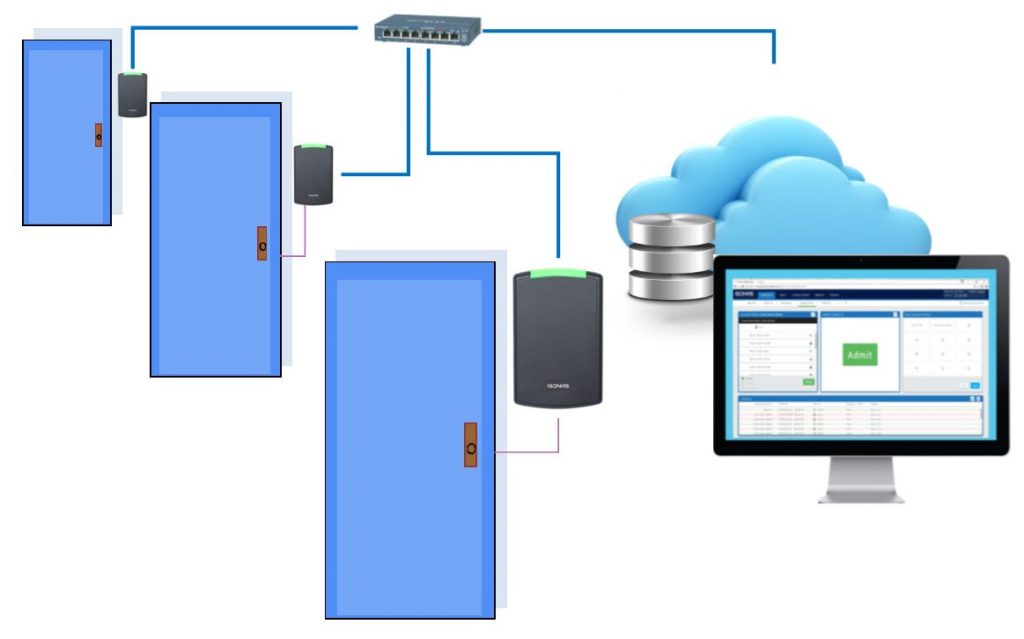
The Isonas IP reader/controller systems are located at the door and don’t require a separate controller. Isonas was the first company to introduce a door reader that included a built-in controller.
This was a dramatic improvement in door access control technology. For the first time, the central controller was no longer needed. It made it very easy to install a single unit and then add units incrementally as required. Wiring was dramatically reduced, and installation was much easier and less costly.
The Isonas IP reader/controller systems are located at the door and don’t require a separate controller. Isonas was the first company to introduce a door reader that included a built-in controller.
This was a dramatic improvement in door access control technology. For the first time, the central controller was no longer needed. It made it very easy to install a single unit and then add units incrementally as required. Wiring was dramatically reduced, and installation was much easier and less costly.
Pro: The IP door reader is attached and powered over the Network (PoE). All the door control functions such as the electric lock, REX, and door sensors are attached to a pigtail connected to the IP door reader. This is a simple system to install. You can add one door at a time. It uses the network infrastructure to connect all the doors readers. The Isonas reader/controller is powered over Ethernet (PoE), and the IP reader provides the power to the lock.
The access control management software is available as a cloud management service, so multiple buildings and locations can all be administered by the same access control management software. There is also an on-site licensed access management software option. The Isonas reader/controller can use mobile credentials.
Con: Reduced flexibility and functionality for enterprise access control applications. The system can’t use special door readers such as biometric readers, long-range readers for gate control, and It doesn’t include an elevator control capability. You require two reader/controllers to provide entry and exit control at the same door. The Biometric reader/controllers require a high-power PoE injector and splitter for power. The outdoor readers require a separate external door kit to protect the reader/controller from vandalism that results in shorting the electric lock control.
Summary: It is the right solution for small to medium applications that don’t require any advanced functionality.
Biometric Network Attached Reader/Controller
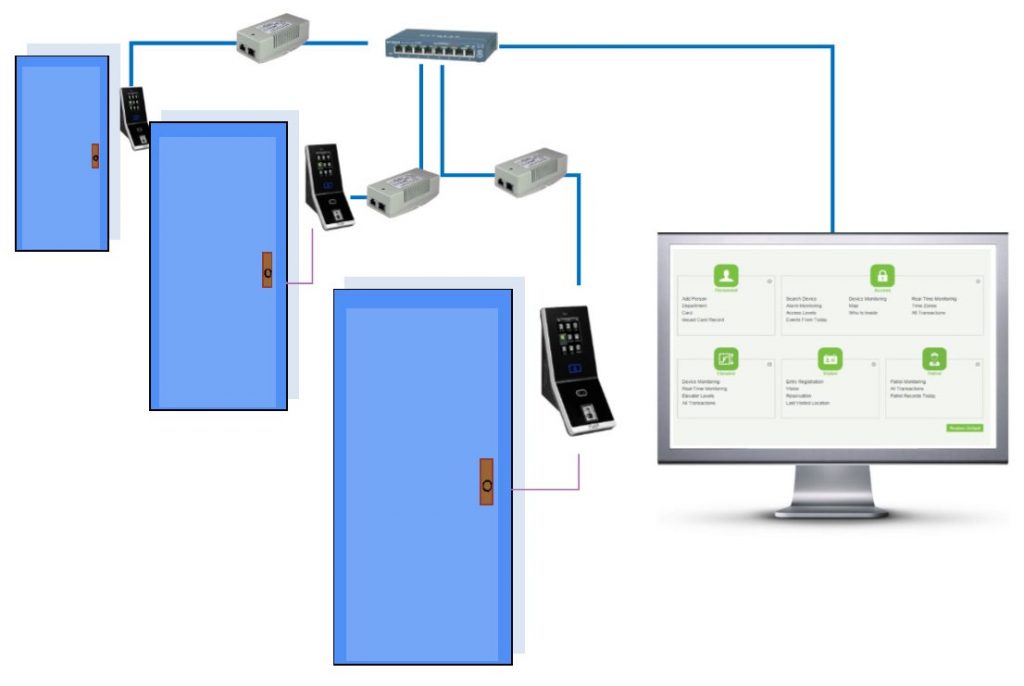
The biometric door/controller access control system is similar to the Isonas IP door readers. Like the Isonas IP reader/controller system, the IP door readers are located at the door and don’t require a separate controller.
There are also controller boxes available that can be used for elevator control and multi-reader door applications. Biometric readers are more complicated and include storage of the biometric templates used as credentials. There are fingerprint readers, facial readers, and finger-vein readers.
Pro: This is a simple system to install. You can add one door at a time. It uses the network infrastructure to connect all the doors in an organization. The reader/controllers are powered by Power over Ethernet (PoE). There is an elevator controller box available that is compatible with the access control management software used with the biometric door readers.
Con: Support for two reader/controllers at the door is only provided by using a controller box. The Biometric reader/controllers can be powered by a separate power supply or using PoE, but they require a high power PoE injector and splitter for power. The biometric readers have limited outdoor capability. Only one of the fingerprint models can be used outdoors but has limited temperature range. The outdoor readers require a separate external door kit to protect the reader/controller from vandalism that results in shorting the electric lock control.
Summary: It is the right solution for small to medium indoor applications where you need the increased security provided by a biometric reader.
Hybrid Door Controller with Reader

The Hartmann, access control system, is a hybrid system that moves the controller to the door and provides increased flexibility. The controller is placed over the door (inside), and there is a large selection of door readers that can be used. The controller attaches to the network and is powered by PoE. The door reader and the electric lock control, REX, door sensors, etc. are wired to the controller. The controller can power the electric lock.
Pro: This is a flexible system that provides added functionality. It is similar to the central controller in that it has a large number of door input and output controls as well as the simplicity of the IP reader/controller systems.
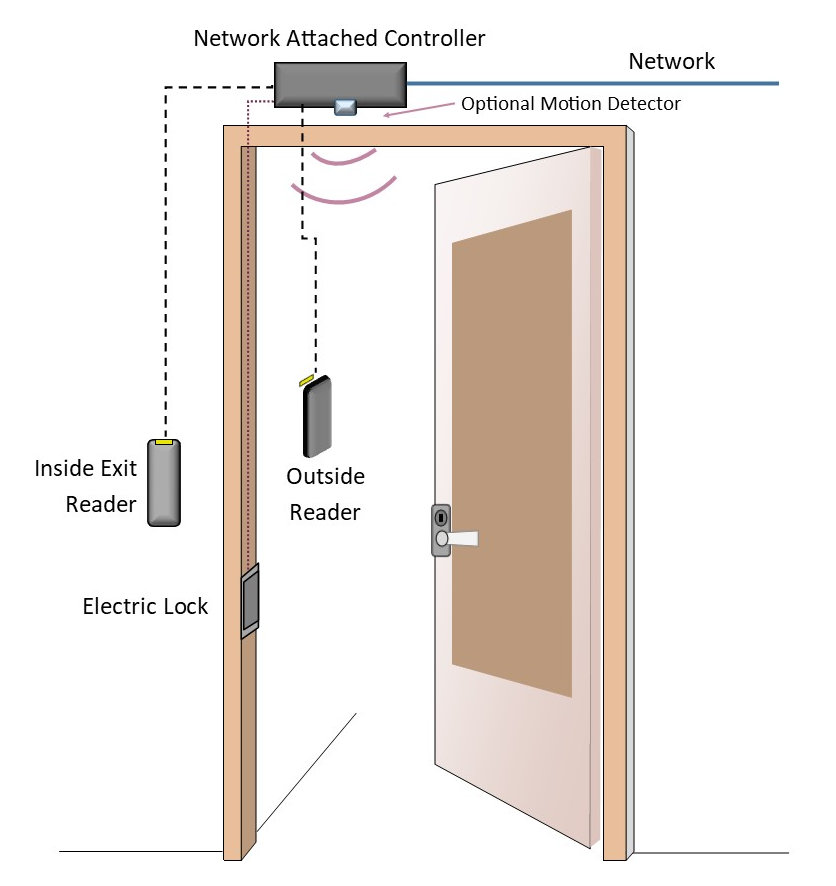
The controller is powered by PoE and can provide power for the electric lock. Two readers (entry and exit) can be attached to the same door controller. There is an optional motion detector available in the door controller that can be used as an automatic electric lock release. This is helpful when the electric lock needs to be opened automatically from inside.
There is an elevator controller that can be used to control floor access. A variety of door readers can be used with the system. For example, a long-range reader can be used to open a gate. Alternatively, you can select a reader that uses mobile credentials. These advanced Bluetooth connected door readers have advanced capabilities. For example, you can open the door by waving your hand over the reader while your smartphone is in your pocket.
The access control management software allows you to control a very large number of doors and the people that use them. It provides advanced functions such as logic if-then functions, control of elevators, visitor management, and integrates with IP camera systems. The software supports multiple sites. The administrators can view and manage a single location or all locations.
Con: The controller needs to be mounted over the door. There is more wiring required since you need to connect the reader to the controller as well as wiring the electric lock connection, REX, door sensor, etc. It is more complicated than the simple Isonas IP reader/controller system.
Summary: It is the right solution for small to enterprise systems that require advanced door access control functions.
Summary of Door Access Control Systems
There are several access control systems that connect to the network. They utilize access control management software that runs on your Windows Computer. Each of the systems has different topographies. The central controller box scheme requires many wire connections from the doors to the central controller. This makes the system the most expensive to install. The Isonas IP door reader/controller doesn’t require the central controller making this system the easiest to install. It is best for small to medium systems that don’t require advanced features. The biometric IP reader/controllers are similar to the Isonas system but add the additional security provided by biometrics. The Hartmann hybrid door access control system is the most flexible. It can be installed one door at a time, so it is a great solution for small access control applications, but it expands to an enterprise solution that requires advanced functions.
For help selecting the right door access control system, please contact us at 800-431-1658 in the USA, or at 914-944-3425 everywhere else, or use our contact form.